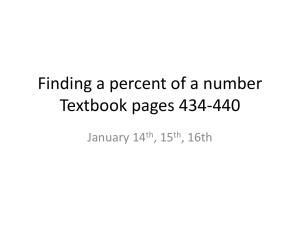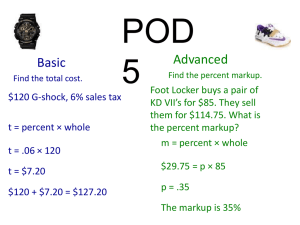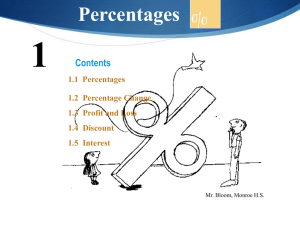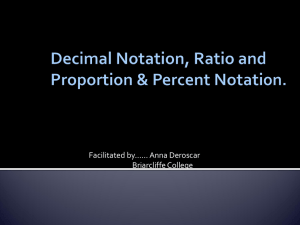PowerPoint - Martin Sewell
advertisement
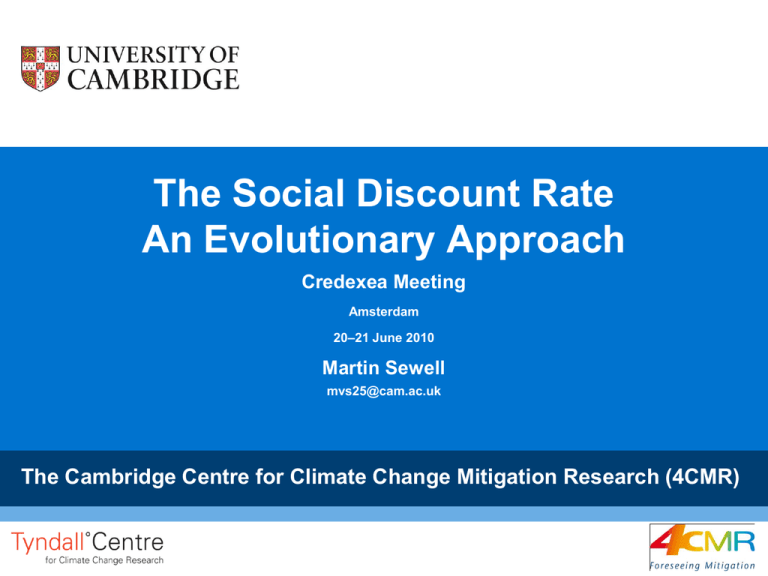
The Social Discount Rate An Evolutionary Approach Credexea Meeting Amsterdam 20–21 June 2010 Martin Sewell mvs25@cam.ac.uk The Cambridge Centre for Climate Change Mitigation Research (4CMR) Social discount rate • How much should we care about the future? • More formally, how should we determine the prescriptive social discount rate? • If we wish to perform a cost-benefit analysis on a future public sector project, such as climate change mitigation, we must choose a discount rate that reflects society’s preference for present benefits over future benefits. Typical social discount rates (r/K selection theory): • developing nations: 8–15% (unstable environment, short life, r-selection) • developed nations: 3–7% (stable environment, longer life, K-selection) Climate change mitigation • The dilemma of climate change mitigation: To what degree should we sacrifice economic growth today so that future generations are less susceptible to the effects of climate change? • The choice of discount rate has a large effect on the result of any climate change mitigation cost-benefit analysis. • The most common criticism of the most comprehensive and widely known report on the economics of climate change, the Stern Review, concerned the discount rate. • Lord Stern used a discount rate of approximately 1.4%, which was lower than that used in most previous studies on the economics of climate change mitigation. • The choice of social discount rate is important. Economics • No consensus on the social discount rate. • What is economics? • The unboundedly rational economic man who seeks to maximize utility is consistent with Homo sapiens if and only if his utility coincides with gene replication. • Wealth is a proxy for the mate value of males, so economics is an approximation of psychology. • Economics is certainly a science, as it focuses on first principles, and science is the pursuit of knowledge that allows us to generalize, so first principles, such as general laws, are key. Philosophy • No consensus on the social discount rate. • The philosopher John Rawls described the problem of intergenerational justice as one that subjects ethical theory to ‘severe if not impossible tests’. • Philosophers consider the social discount rate a moral judgement. • Morality is a product of the gene-centred evolutionary forces which shape human social psychology. • We have evolved as if our sole goal was to propagate our genes, and morality has evolved only insofar as it helps us achieve that goal. • Science trumps philosophy. Biology • Thus far, philosophy and economics have failed to come up with any consensus. • Economics is an approximation of psychology, which is reducible to biology. • Philosophy concerns itself with morality, which is biology. • Naturally, we turn to biology. • We take a bottom-up evolutionary approach in search of an objective solution to our original question, what is the prescriptive social discount rate? Evolutionary psychology • Homo sapiens originated about 200,000 years ago • Natural selection is a slow process • Our minds today are adapted to maximize gene replication in the Pleistocene • Lasted from 1.8 million to 12,000 years before the present • Hunter-gatherer tribes on the African savannah • For example, in the present we are more afraid of snakes and spiders than cars, despite the fact that cars cause more deaths and injuries than creatures in developed countries. • No alternative hypothesis Need to know • Although humans are simply vehicles that have evolved as if to help ensure that their genes survive in perpetuity, all that is required of individuals is that they are motivated to reproduce, so we seek to maximize gene replication within our lifetime, but not beyond. • In short, we have evolved on a ‘need to know’ basis, or rather, a ‘need to feel’ basis. • A minority of people deceive themselves into caring about the long-term future because this helps them achieve their goal, via their enhanced status among their like-minded peers, of reproduction. • Everything we do is either reproduction, or instrumental to it. Time discounting • No one takes the future quite as seriously as the present. • People generally prefer to have benefits today rather than in the future. • Time discounting pertains to how large a premium an individual will place on receiving a reward nearer in time relative to a more remote reward. • If one is hoping for a future reward, such as a reproductive opportunity with a potential partner, there is a risk that the expected future reward will not, in fact, be available. • For example, the prospective partner may find another mate, or worse, you could die before receiving the reward. • There is also the opportunity cost to consider, the time spent waiting for a delayed reward may be time wasted. Hyperbolic or exponential discount function? • During a lifetime, generally the risk that a reward will not be available decreases as one approaches the time that the reward is expected, which leads to a hyperbolic discount function. • The exponential function is the only discount function that provides timeconsistent preferences. • The exponential discounting assumption is the most commonly used in economics. • There is more empirical evidence for hyperbolic discounting. Discount rate during the Pleistocene • Taking an evolutionary psychology perspective amplifies the magnitude and frequency of occasions that warrant a high discount rate, and also those that warrant a low discount rate. • On the one hand the hostile environment of the Pleistocene would have increased the number of instances when it made sense to care only about the immediate future, such as fleeing from an imminent danger. • On the other hand living in small groups would have provided greater opportunities for repeated transactions with the same individuals, which would have led to greater cooperation and lowering the discount rate. • It could be that emotions evolved to help solve the impulse control problem by allowing us to lower the discount rate in selected instances. Is-ought problem • David Hume noted that many writers make claims about what ought to be on the basis of statements about what is. • My account thus far, of how we have evolved, has been descriptive. • We cannot transcend our genes, so our motivational set is not negotiable. • A prescriptive social discount rate must accommodate our motivational set, so optimally coincides with the descriptive model. • The social discount rate ought to be what it is. Conclusion • An individual’s discount function is hyperbolic and reaches 100% at the end of their lifetime. • An equitable social discount function should average the population’s individual discount functions. • Such prescriptive myopic behaviour is consistent with both reality and the human race prospering in perpetuity. • Worry about the short-term, and the long term will look after itself. • Take each game as it comes. Martin Sewell mvs25@cam.ac.uk


